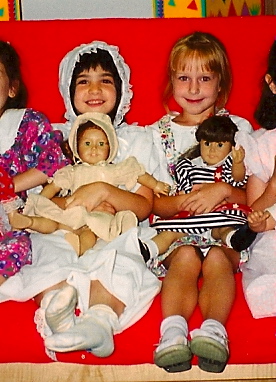
by Emma Gray
An Ode to the American Girl… Doll.
 Recently, Jezebel alerted me to the fact that American Girl was retiring its Revolutionary War doll, Felicity Merriman. I got incredibly sad at the news, although my Felicity doll has long-been tucked away in the basement of my family’s house in Maryland. It also got me thinking about American Girl dolls, and their symbolic significance.
Recently, Jezebel alerted me to the fact that American Girl was retiring its Revolutionary War doll, Felicity Merriman. I got incredibly sad at the news, although my Felicity doll has long-been tucked away in the basement of my family’s house in Maryland. It also got me thinking about American Girl dolls, and their symbolic significance.
I recognize my own privilege in owning even one of these dolls. To buy one doll and one book costs nearly $100, which means that they are only available to a small sector of the population. The price factor alone greatly skews the company’s target audience and therefore determines what is produced.
 That being said, the dolls gave me a wonderfully empowering way to connect personally with US history. Their stories were fascinating and varied, and I read the books voraciously. From Swedish immigrant Kirsten and slave-girl Addy, to WWII-era Molly and suffragette Samantha, I connected to these girls and their narratives.
That being said, the dolls gave me a wonderfully empowering way to connect personally with US history. Their stories were fascinating and varied, and I read the books voraciously. From Swedish immigrant Kirsten and slave-girl Addy, to WWII-era Molly and suffragette Samantha, I connected to these girls and their narratives.
The experiences of women, and especially girls, are so often erased from our textbooks and collective historical memories. The American Girl dolls were one of my few reminders that women played immeasurable roles in the historical events that we cling to as a culture. Young women were immigrants, loyalists, revolutionaries, slaves and activists – even if they receive little recognition.
But when I worshiped these fictional ladies, every American Girl celebrated Christmas. In all of my empowered connectedness to these girls and their adventures, I always felt something lacking. Where was MY history?
 It was there partially, as I have always felt connected to my identity as an American. But my family’s trajectory was nowhere to be found in these girls’ stories. Each time the glossy catalogue was sent to our house, I doggedly perused it, secretly hoping that a Jewish doll would appear in its pages. As a child, it seemed so important that I find an AG story that validated my story. Rebecca Rubin now exists, but she did not become a reality until long after I lost interest in these American Girls.
It was there partially, as I have always felt connected to my identity as an American. But my family’s trajectory was nowhere to be found in these girls’ stories. Each time the glossy catalogue was sent to our house, I doggedly perused it, secretly hoping that a Jewish doll would appear in its pages. As a child, it seemed so important that I find an AG story that validated my story. Rebecca Rubin now exists, but she did not become a reality until long after I lost interest in these American Girls.
The truth is that every girl deserves to see representations of herself and her history. American Girl dolls have the potential to be amazing educational tools and empowering symbols for all young women, but there is still much progress to be made in the AG universe. First of all, keep pumping up the racial diversity! Secondly, knock down the price! It’s not as though upper middle-class girls have a premium on history (or HERstory).
–Emma Gray